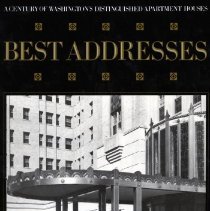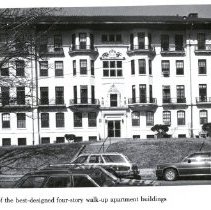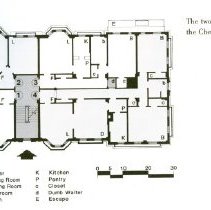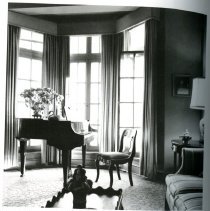Library Record
Images




Metadata
Object ID |
2008.70.03.01 |
Title |
Best Addresses: A Century of Washington's Distinguished Apartment Houses |
Object Name |
Book |
Author |
Goode, James M. |
Publisher |
Smithsonian Institution Press |
Published Date |
1988 |
Published Place |
Washington, D.C. |
Description |
Best Addresses - A Century of Washington's Distinguished Apartment Houses by James M. Goode Smithsonian Institution Press, Washington, DC, London 1988 Photographs by James Stafford Phillips and James F. Tetro p. 92-94 Maps on lining papers. Includes index. Bibliography: p. 550-583. CHEVY CHASE 5863 Chevy Chase Parkway, N.W.; northeast corner of Chevy Chase Circle and Chevy Chase Parkway ARCHITECT: Leon E. Dessez, 1909 APARTMENTS: 16 (8 one-bedrooms; 8 two-bedrooms) STATUS: opened as rental in 1910 Prominently located on the east side of Chevy Chase Circle, only fifty feet from the Maryland state line, the Chevy Chase is one of the smaller of the dozen Spanish Colonial style apartment buildings erected in the city before World War I. As such, it has a stucco facade, wide eaves, red-tile roof, and an elaborate plaster baroque entablature over the main entrance and the staircase hall, window above. These features are the most expressive the Spanish Colonial style for a Washington apartment building of the period. It was designed in 1909 as a freestanding suburban apartment building with spacious lawns on all sides. At the time it was built, very few residences existed in this immediate neighborhood. It was the first true suburban Washington apartment building. Even though this residence has no public lobby or elevator, it is important for its handsome facade design as well as for its floor plan. Half of the sixteen apartments are large four-room units, each with three exposures. Additional light fills apartments above the first floor through the pair of oriel windows designed for both the front and rear facades. The windows on the second and fourth floors, with their handsome balconies, are considerably taller than those on the first and third floors. Apartments at the west end of the building overlook Chevy Chase Circle, with its elegant circular fountain and abundance of trees. The Chevy Chase's two entrances, opposite one another, bisect the center of the building. The staircase hall and landings have marble floors and marble wainscoting throughout. Each floor has four apartments; the larger two-bedroom units face the front, onto Chevy Chase Parkway, while the two one-bedroom units face Western Avenue in the rear. The handsome chestnut woodwork in all of the apartments was originally stained a dark walnut color. Only one apartment, No. 21, occupied by Miss Louise O'Neal since 1929, remains with this original finish. The remainder have been painted white, a custom that first became standard in Washington apartment houses in the early 1920s. The dumbwaiters, with their vertically sliding doors, are still located in the long hall opposite the kitchen door in each unit. The basement has the standard laundry, storage rooms, and janitor's apartment. Although Miss O'Neal's residence in the Chevy Chase exceeds fifty-five years, that of the janitor, Ralph Crawford, sets the record for the building. He was born here before World War I when his father, Emmet, was the first janitor. Ralph Crawford succeeded his father in 1935 and remains in charge of the building today. The land adjacent to the Chevy Chase to the east was purchased in 1911 by the newly formed Catholic church, the Shrine of the Most Blessed Sacrament. The congregation, half in Washington and half in Maryland, compromised on a location, building a small wooden chapel next to Chevy Chase Circle as close to the boundary line as possible. This early building was replaced by the present handsome stone church in 1925. The congregation purchased the Chevy Chase apartment building in 1962 in order to protect the church property against possible future development. Blessed Sacrament, which continues to operate the Chevy Chase, is dedicated to preserving its important original exterior and interior architectural design. ARCHITECT LEON E. DESSEZ The architect of the Chevy Chase, Leon E. Dessez (1858-1918), was born to European immigrants—a French father and a German mother, who settled in Washington in the 1850s. His father, an engineer and builder, worked for the Confederacy on military fortifications, but the family remained in Washington during the Civil War years. Young Dessez entered a career in architecture at the age of 19, in 1877, when he began work in the office of Hornblower and Poindexter, soon to become Hornblower and Marshall and one of the city's most prominent late-Victorian architectural firms. He worked as an architectural assistant on the completion of the Washington Monument and then on architectural projects at the Washington Navy YaRoad After nine years of architectural work in other offices, he opened his own firm in 1886, in the Corcoran Building at 15th Street and Pennsylvania Avenue, N.W., where many Washington architects were located. The next year he and a handful of other local architects founded the Washington chapter of the American Institute of Architects. Dessez left a marked impact on Washington as the leading architect in the newly developing Maryland suburb of Chevy Chase. He was the director and chief architect of the Chevy Chase Land Company for twenty-five years, from its founding in 1893 until his death. Although he specialized in large houses, such as the Francis Newlands house on Chevy Chase Circle and the Admiral's House (now the Vice President's House) on Observatory Circle, he designed many other building types. Before his death in 1918, Dessez designed a variety of important buildings, including the Raleigh Hotel, the hospital at the Soldiers Home, and many fire stations, such as Engine Company No. 2 at 719 12th Street, N.W. (razed in 1986), as well as numerous freestanding houses. Dessez's four Washington apartment houses were designed between 1899 and 1901. |
